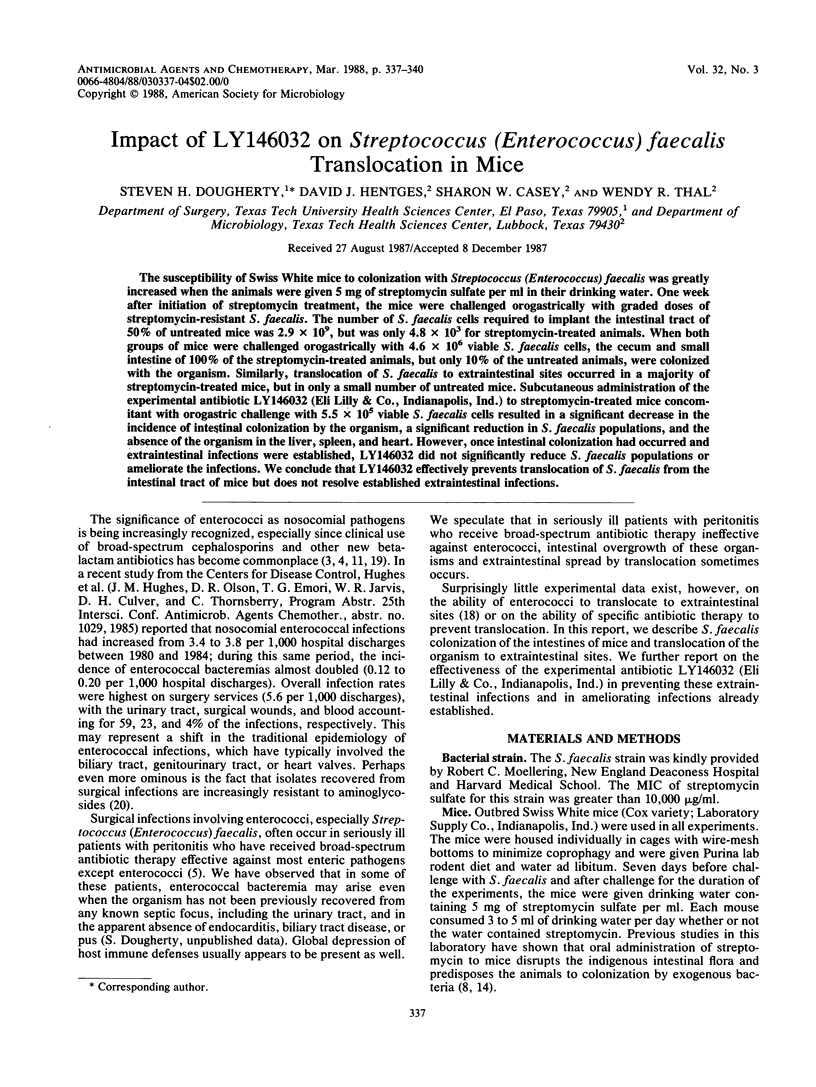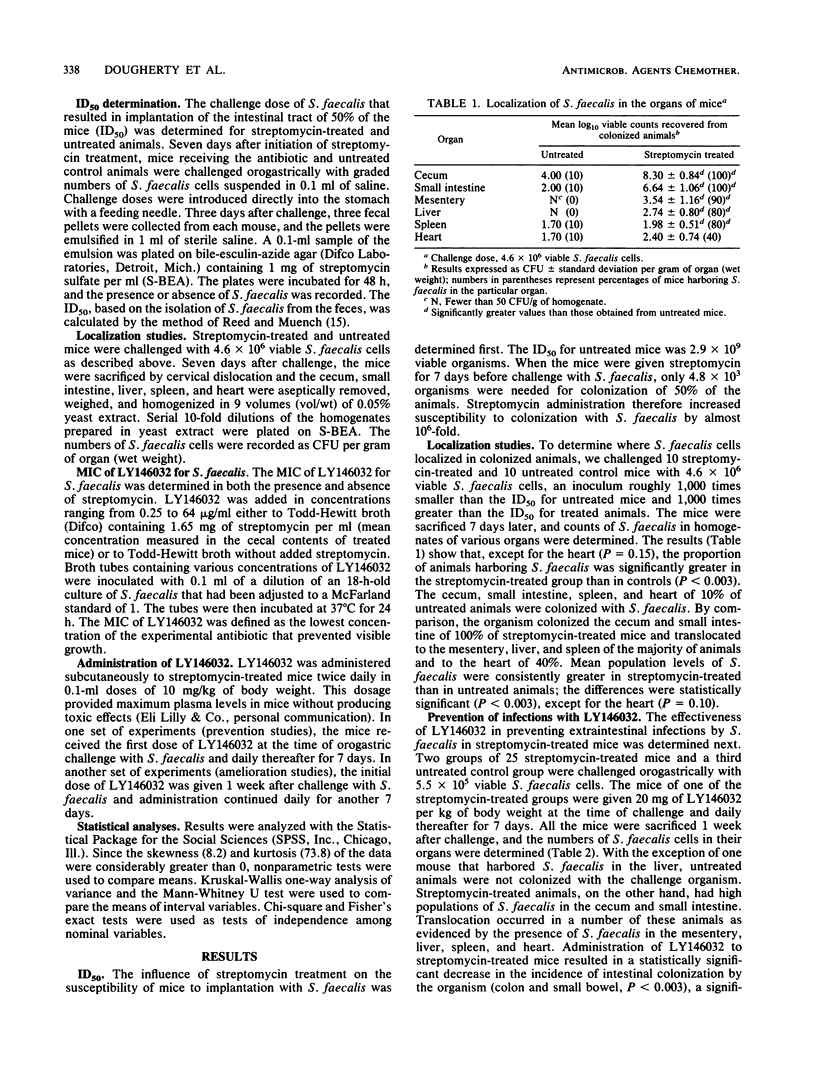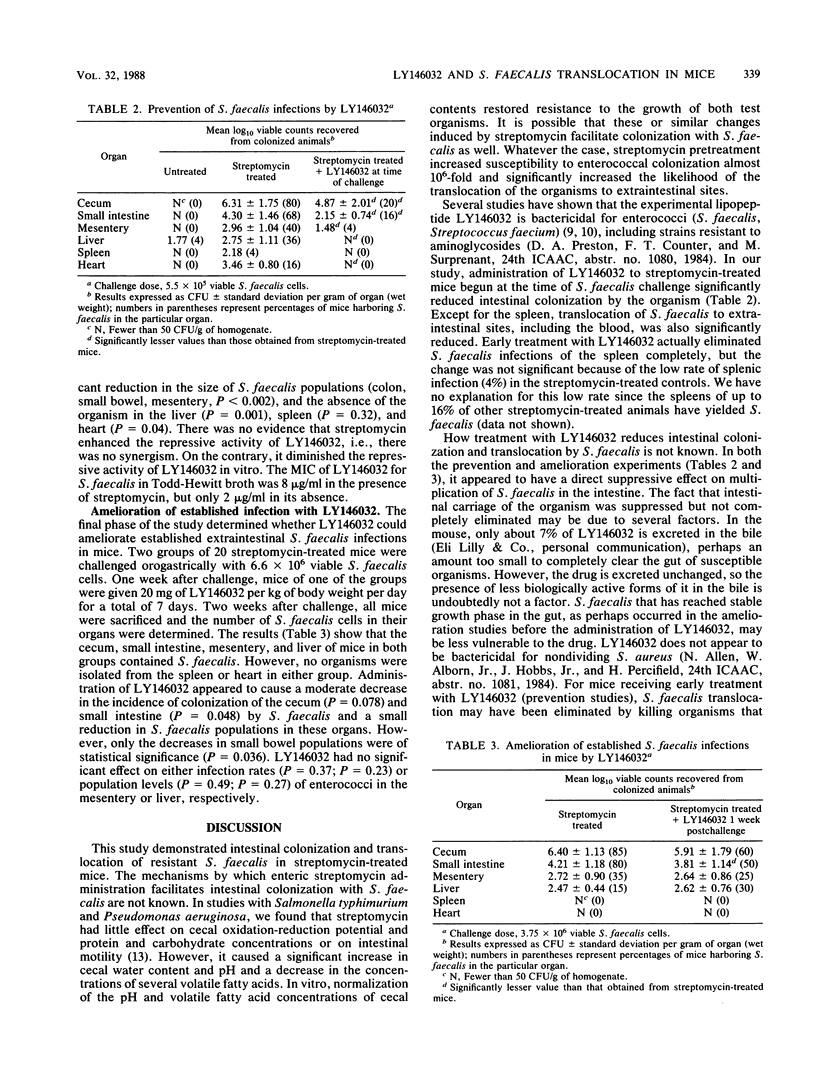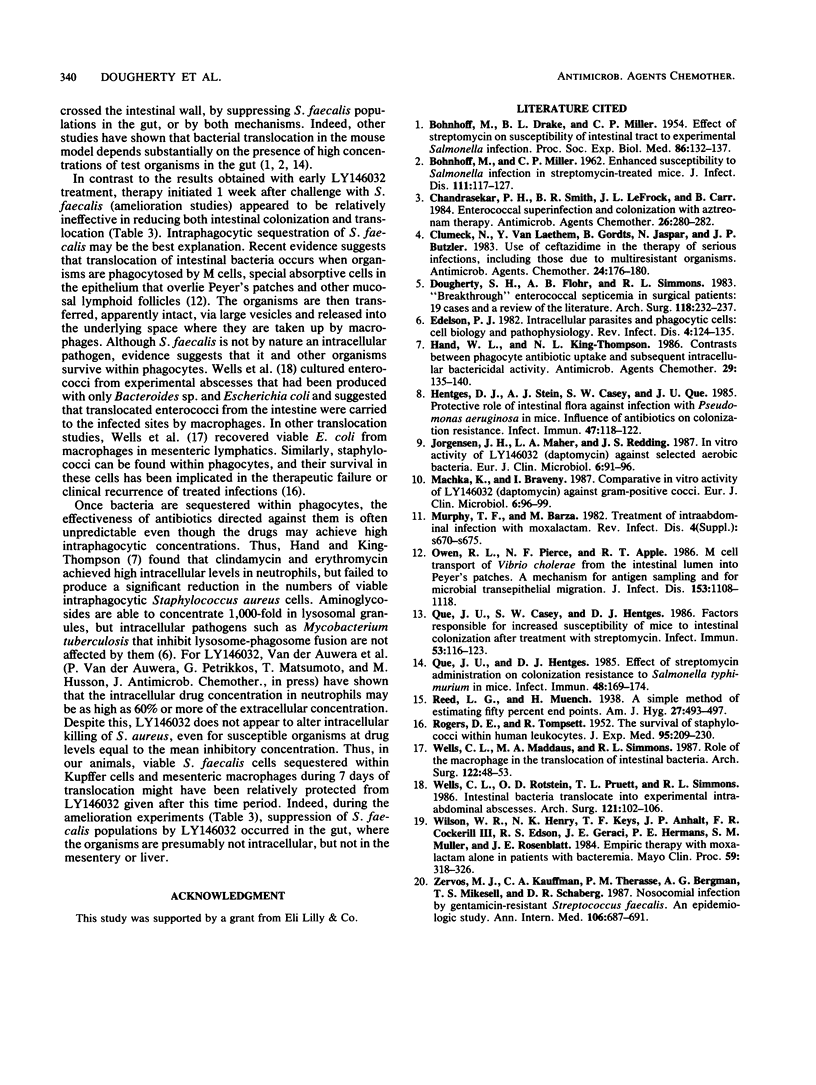Abstract
The susceptibility of Swiss White mice to colonization with Streptococcus (Enterococcus) faecalis was greatly increased when the animals were given 5 mg of streptomycin sulfate per ml in their drinking water. One week after initiation of streptomycin treatment, the mice were challenged orogastrically with graded doses of streptomycin-resistant S. faecalis. The number of S. faecalis cells required to implant the intestinal tract of 50% of untreated mice was 2.9 X 10(9), but was only 4.8 X 10(3) for streptomycin-treated animals. When both groups of mice were challenged orogastrically with 4.6 X 10(6) viable S. faecalis cells, the cecum and small intestine of 100% of the streptomycin-treated animals, but only 10% of the untreated animals, were colonized with the organism. Similarly, translocation of S. faecalis to extraintestinal sites occurred in a majority of streptomycin-treated mice, but in only a small number of untreated mice. Subcutaneous administration of the experimental antibiotic LY146032 (Eli Lilly & Co., Indianapolis, Ind.) to streptomycin-treated mice concomitant with orogastric challenge with 5.5 X 10(5) viable S. faecalis cells resulted in a significant decrease in the incidence of intestinal colonization by the organism, a significant reduction in S. faecalis populations, and the absence of the organism in the liver, spleen, and heart. However, once intestinal colonization had occurred and extraintestinal infections were established, LY146032 did not significantly reduce S. faecalis populations or ameliorate the infections. We conclude that LY146032 effectively prevents translocation of S. faecalis from the intestinal tract of mice but does not resolve established extraintestinal infections.
Full text
PDF



Selected References
These references are in PubMed. This may not be the complete list of references from this article.
- BOHNHOFF M., DRAKE B. L., MILLER C. P. Effect of streptomycin on susceptibility of intestinal tract to experimental Salmonella infection. Proc Soc Exp Biol Med. 1954 May;86(1):132–137. doi: 10.3181/00379727-86-21030. [DOI] [PubMed] [Google Scholar]
- BOHNHOFF M., MILLER C. P. Enhanced susceptibility to Salmonella infection in streptomycin-treated mice. J Infect Dis. 1962 Sep-Oct;111:117–127. doi: 10.1093/infdis/111.2.117. [DOI] [PubMed] [Google Scholar]
- Chandrasekar P. H., Smith B. R., LeFrock J. L., Carr B. Enterococcal superinfection and colonization with aztreonam therapy. Antimicrob Agents Chemother. 1984 Aug;26(2):280–282. doi: 10.1128/aac.26.2.280. [DOI] [PMC free article] [PubMed] [Google Scholar]
- Clumeck N., Van Laethem Y., Gordts B., Jaspar N., Butzler J. P. Use of ceftazidime in the therapy of serious infections, including those due to multiresistant organisms. Antimicrob Agents Chemother. 1983 Aug;24(2):176–180. doi: 10.1128/aac.24.2.176. [DOI] [PMC free article] [PubMed] [Google Scholar]
- Dougherty S. H., Flohr A. B., Simmons R. L. 'Breakthrough' enterococcal septicemia in surgical patients. 19 cases and a review of the literature. Arch Surg. 1983 Feb;118(2):232–238. doi: 10.1001/archsurg.1983.01390020076013. [DOI] [PubMed] [Google Scholar]
- Edelson P. J. Intracellular parasites and phagocytic cells: cell biology and pathophysiology. Rev Infect Dis. 1982 Jan-Feb;4(1):124–135. doi: 10.1093/clinids/4.1.124. [DOI] [PubMed] [Google Scholar]
- Hand W. L., King-Thompson N. L. Contrasts between phagocyte antibiotic uptake and subsequent intracellular bactericidal activity. Antimicrob Agents Chemother. 1986 Jan;29(1):135–140. doi: 10.1128/aac.29.1.135. [DOI] [PMC free article] [PubMed] [Google Scholar]
- Hentges D. J., Stein A. J., Casey S. W., Que J. U. Protective role of intestinal flora against infection with Pseudomonas aeruginosa in mice: influence of antibiotics on colonization resistance. Infect Immun. 1985 Jan;47(1):118–122. doi: 10.1128/iai.47.1.118-122.1985. [DOI] [PMC free article] [PubMed] [Google Scholar]
- Jorgensen J. H., Maher L. A., Redding J. S. In vitro activity of LY146032 (daptomycin) against selected aerobic bacteria. Eur J Clin Microbiol. 1987 Feb;6(1):91–96. doi: 10.1007/BF02097209. [DOI] [PubMed] [Google Scholar]
- Machka K., Braveny I. Comparative in vitro activity of LY146032 (daptomycin) against gram-positive cocci. Eur J Clin Microbiol. 1987 Feb;6(1):96–99. doi: 10.1007/BF02097210. [DOI] [PubMed] [Google Scholar]
- Murphy T. F., Barza M. Treatment of intraabdominal infection with moxalactam. Rev Infect Dis. 1982 Nov-Dec;4 (Suppl):S670–S675. doi: 10.1093/clinids/4.supplement_3.s670. [DOI] [PubMed] [Google Scholar]
- Owen R. L., Pierce N. F., Apple R. T., Cray W. C., Jr M cell transport of Vibrio cholerae from the intestinal lumen into Peyer's patches: a mechanism for antigen sampling and for microbial transepithelial migration. J Infect Dis. 1986 Jun;153(6):1108–1118. doi: 10.1093/infdis/153.6.1108. [DOI] [PubMed] [Google Scholar]
- Que J. U., Casey S. W., Hentges D. J. Factors responsible for increased susceptibility of mice to intestinal colonization after treatment with streptomycin. Infect Immun. 1986 Jul;53(1):116–123. doi: 10.1128/iai.53.1.116-123.1986. [DOI] [PMC free article] [PubMed] [Google Scholar]
- Que J. U., Hentges D. J. Effect of streptomycin administration on colonization resistance to Salmonella typhimurium in mice. Infect Immun. 1985 Apr;48(1):169–174. doi: 10.1128/iai.48.1.169-174.1985. [DOI] [PMC free article] [PubMed] [Google Scholar]
- ROGERS D. E., TOMPSETT R. The survival of staphylococci within human leukocytes. J Exp Med. 1952 Feb;95(2):209–230. doi: 10.1084/jem.95.2.209. [DOI] [PMC free article] [PubMed] [Google Scholar]
- Wells C. L., Maddaus M. A., Simmons R. L. Role of the macrophage in the translocation of intestinal bacteria. Arch Surg. 1987 Jan;122(1):48–53. doi: 10.1001/archsurg.1987.01400130054008. [DOI] [PubMed] [Google Scholar]
- Wells C. L., Rotstein O. D., Pruett T. L., Simmons R. L. Intestinal bacteria translocate into experimental intra-abdominal abscesses. Arch Surg. 1986 Jan;121(1):102–107. doi: 10.1001/archsurg.1986.01400010116016. [DOI] [PubMed] [Google Scholar]
- Wilson W. R., Henry N. K., Keys T. F., Anhalt J. P., Cockerill F. R., 3rd, Edson R. S., Geraci J. E., Hermans P. E., Muller S. M., Rosenblatt J. E. Empiric therapy with moxalactam alone in patients with bacteremia. Mayo Clin Proc. 1984 May;59(5):318–326. doi: 10.1016/s0025-6196(12)61427-x. [DOI] [PubMed] [Google Scholar]
- Zervos M. J., Kauffman C. A., Therasse P. M., Bergman A. G., Mikesell T. S., Schaberg D. R. Nosocomial infection by gentamicin-resistant Streptococcus faecalis. An epidemiologic study. Ann Intern Med. 1987 May;106(5):687–691. doi: 10.7326/0003-4819-106-5-687. [DOI] [PubMed] [Google Scholar]


